François Baccelli
Unified Modeling and Rate Coverage Analysis for Satellite-Terrestrial Integrated Networks: Coverage Extension or Data Offloading?
Jul 07, 2023Abstract:With the growing interest in satellite networks, satellite-terrestrial integrated networks (STINs) have gained significant attention because of their potential benefits. However, due to the lack of a tractable network model for the STIN architecture, analytical studies allowing one to investigate the performance of such networks are not yet available. In this work, we propose a unified network model that jointly captures satellite and terrestrial networks into one analytical framework. Our key idea is based on Poisson point processes distributed on concentric spheres, assigning a random height to each point as a mark. This allows one to consider each point as a source of desired signal or a source of interference while ensuring visibility to the typical user. Thanks to this model, we derive the probability of coverage of STINs as a function of major system parameters, chiefly path-loss exponent, satellites and terrestrial base stations' height distributions and density, transmit power and biasing factors. Leveraging the analysis, we concretely explore two benefits that STINs provide: i) coverage extension in remote rural areas and ii) data offloading in dense urban areas.
Cox Point Processes for Multi-Altitude LEO Satellite Networks
Jan 06, 2023Abstract:We propose a simple analytical approach to describe the locations of low earth orbit (LEO) satellites based on a Cox point process. We develop a variable-altitude Poisson orbit process by accounting for the fact that satellites are always located on circular orbits and these orbits may have different altitudes. Then, the satellites on these orbits are modeled as the Poisson point processes conditionally on the orbit process. For this model, we derive the distribution of the distance to the nearest visible satellite, the outage probability, the Laplace functional of the proposed satellite Cox point process, and the Laplace transform of the interference under a general fading. The derived statistics allow one to evaluate the performance of such LEO satellite communication systems as functions of network parameters.
An Analytical Framework for Downlink LEO Satellite Communications based on Cox Point Processes
Dec 07, 2022Abstract:This work develops an analytical framework for downlink low earth orbit (LEO) satellite communications, leveraging tools from stochastic geometry. We propose a tractable approach to the analysis of such satellite communication systems accounting for the fact that satellites are located on circular orbits. We accurately characterize this geometric property of such LEO satellite constellations by developing a Cox point process model that jointly produces orbits and satellites on these orbits. Our work differs from existing studies that have assumed satellites' locations as completely random binomial point processes. For this Cox model, we derive the outage probability of the proposed network and the distribution of the signal-to-interference-plus-noise ratio (SINR) of an arbitrarily located user in the network. By determining various network performance metrics as functions of key network parameters, this work allows one to assess the statistical properties of downlink LEO satellite communications and thus can be used as a system-level design tool.
Modeling and Analysis of 2-Tier Heterogeneous Vehicular Networks Leveraging Roadside Units and Vehicle Relays
Apr 26, 2022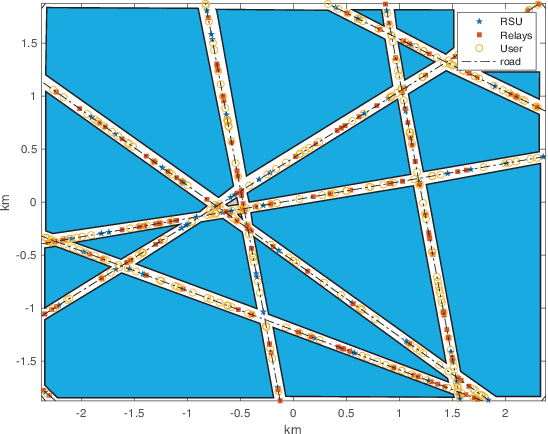
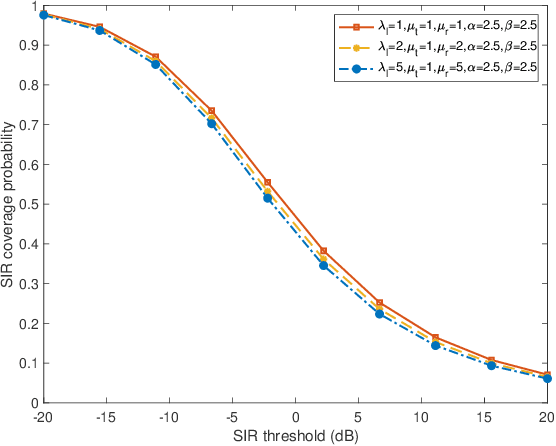
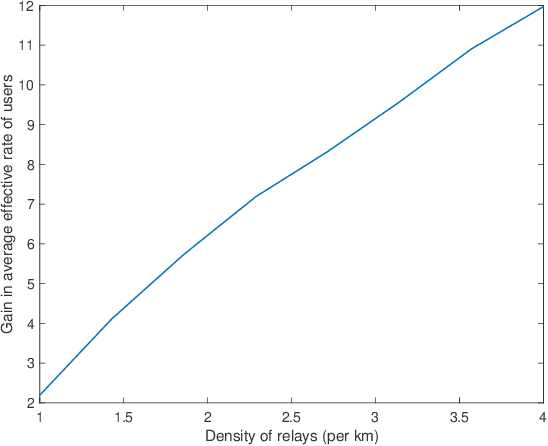
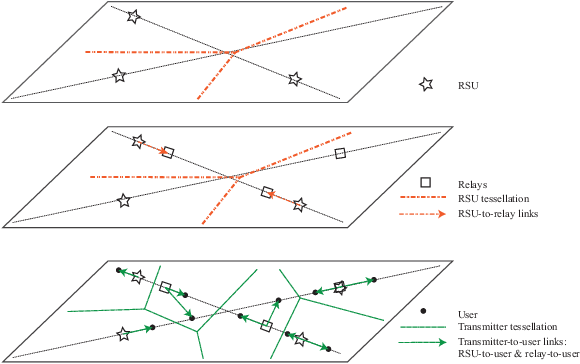
Abstract:While roadside units (RSUs) play an essential role in vehicle-to-everything (V2X) by communicating with users, some users in congestion areas may not be well-served due to data traffic, signal attenuation, and interference. In these cases, vehicle relays can be employed to enhance the network topology to better serve those users. This paper leverages stochastic geometry to propose a novel framework for the performance analysis of heterogeneous vehicular networks with RSUs, vehicle relays, and vehicle users. We present a two-dimensional analytical model where the spatial dependence between RSUs, vehicle relays, vehicle users, and roads is accurately taken into account through a Cox point process structure. Assuming relays are backhauled to RSUs over a reserved wireless resource and users are associated with the closest RSU or relay, we derive the probability that the typical user is associated with either an RSU or a relay. Then, we derive the signal-to-interference ratio (SIR) coverage probability of the typical user. Finally, using the derived formulas, we evaluate the average effective rate of the typical user in the network. This allows us to determine the gain of the average effective rate of users that results from the deployment of relays in the network.
An Analysis of LOS Coverage in Vehicular Networks with Roadside Units and Relays
Oct 26, 2021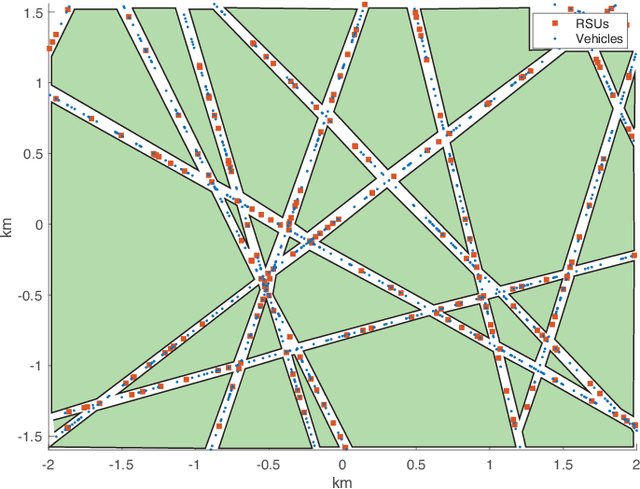
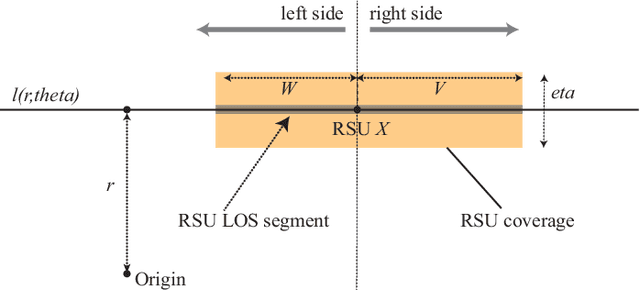
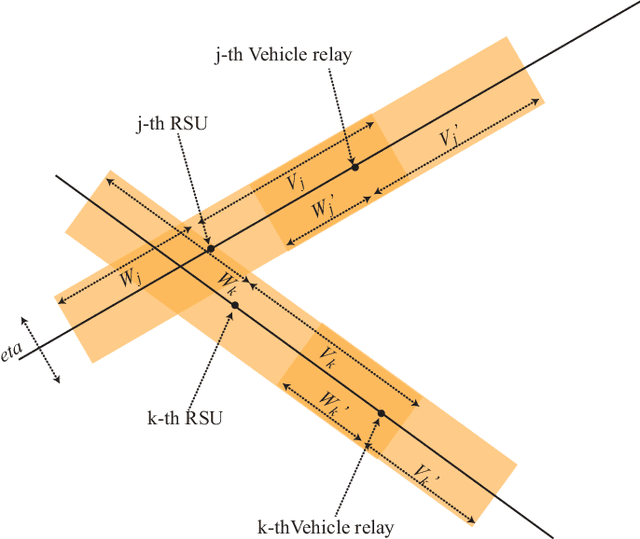
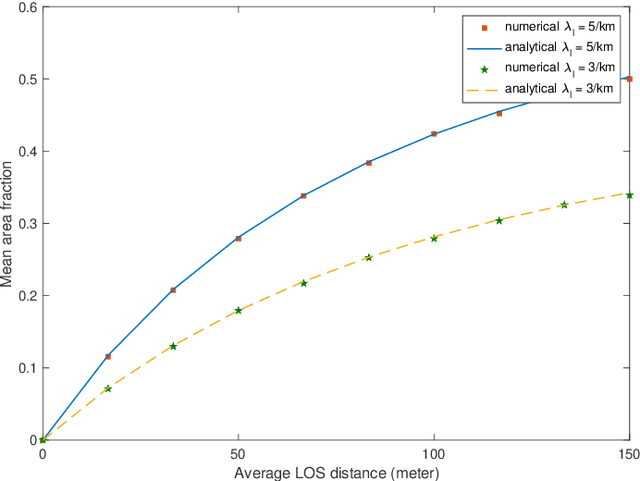
Abstract:This paper analyzes the use of vehicular relays as a means to extend the Line-of-Sight (LOS) coverage from roadside units(RSUs) toward users on the streets in mmWave or visible light communications. In this paper, we consider the scenario where RSUs select vehicles within their LOS coverage as relays. As a result, the LOS coverage of those RSUs is extended by the LOS coverage newly provided by the vehicular relays. To account for the spatial relationship between vehicles and RSUs, we use Cox point processes. We assume that the LOS distances from RSUs or relays are independent and exponentially distributed. To address the spatial interactions between RSU LOS coverage and relay LOS coverage, we use the notion of mean area fraction to evaluate the LOS coverage.
A Random Geometric Model of Blockages in Vehicular Networks
Aug 24, 2021

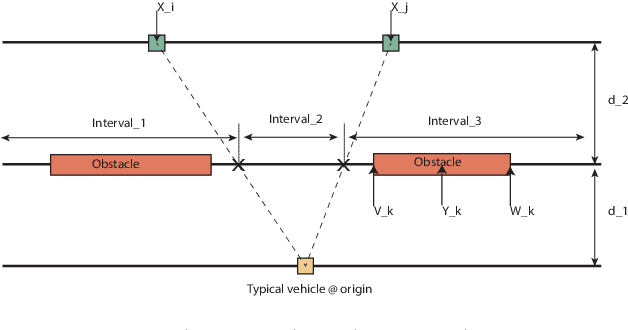
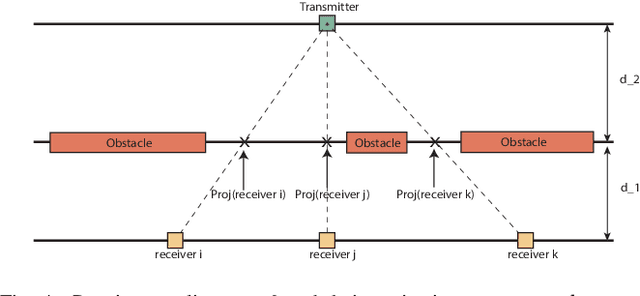
Abstract:This paper presents a novel spatially consistent approach for modeling line-of-sight (LOS) paths in vehicular networks. We use stochastic geometry to model transmitters, obstacles, and receivers located in three parallel lines, respectively. Their geometric interactions are leveraged to characterize the existence of LOS paths. Specifically, the proposed approach focuses on the role of obstacles in blocking one or more LOS paths, which has been overlooked in most statistical models for blockage. Under the proposed framework, we derive the probability that a typical vehicle is in LOS with respect to transmitters with received signal-to-noise ratios greater than a threshold. The proposed framework and LOS coverage analysis are instrumental to the analysis of LOS-critical applications such as positioning or mmWave communications in vehicular networks.
ComHapDet: A Spatial Community Detection Algorithm for Haplotype Assembly
Nov 27, 2019



Abstract:Background: Haplotypes, the ordered lists of single nucleotide variations that distinguish chromosomal sequences from their homologous pairs, may reveal an individual's susceptibility to hereditary and complex diseases and affect how our bodies respond to therapeutic drugs. Reconstructing haplotypes of an individual from short sequencing reads is an NP-hard problem that becomes even more challenging in the case of polyploids. While increasing lengths of sequencing reads and insert sizes {\color{black} helps improve accuracy of reconstruction}, it also exacerbates computational complexity of the haplotype assembly task. This has motivated the pursuit of algorithmic frameworks capable of accurate yet efficient assembly of haplotypes from high-throughput sequencing data. Results: We propose a novel graphical representation of sequencing reads and pose the haplotype assembly problem as an instance of community detection on a spatial random graph. To this end, we construct a graph where each read is a node with an unknown community label associating the read with the haplotype it samples. Haplotype reconstruction can then be thought of as a two-step procedure: first, one recovers the community labels on the nodes (i.e., the reads), and then uses the estimated labels to assemble the haplotypes. Based on this observation, we propose ComHapDet - a novel assembly algorithm for diploid and ployploid haplotypes which allows both bialleleic and multi-allelic variants. Conclusions: Performance of the proposed algorithm is benchmarked on simulated as well as experimental data obtained by sequencing Chromosome $5$ of tetraploid biallelic \emph{Solanum-Tuberosum} (Potato). The results demonstrate the efficacy of the proposed method and that it compares favorably with the existing techniques.
 Add to Chrome
Add to Chrome Add to Firefox
Add to Firefox Add to Edge
Add to Edge